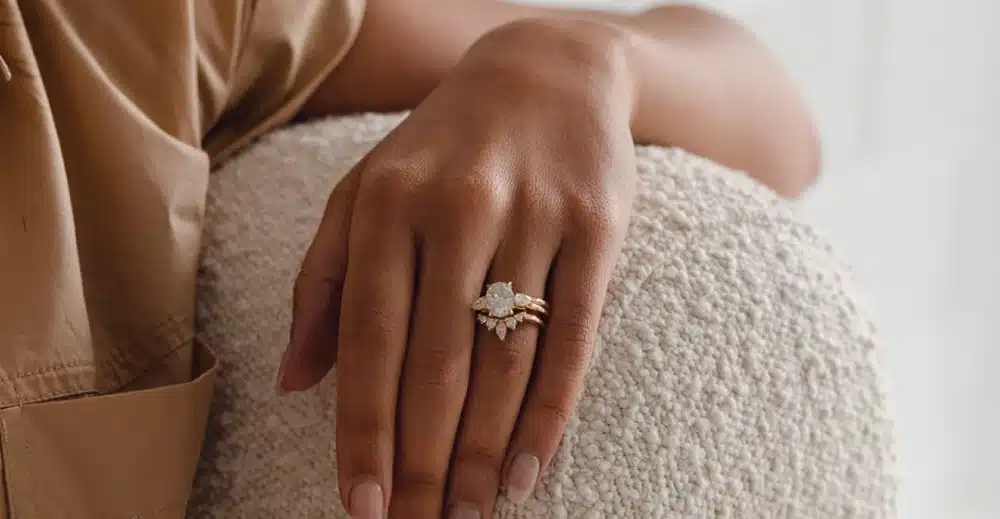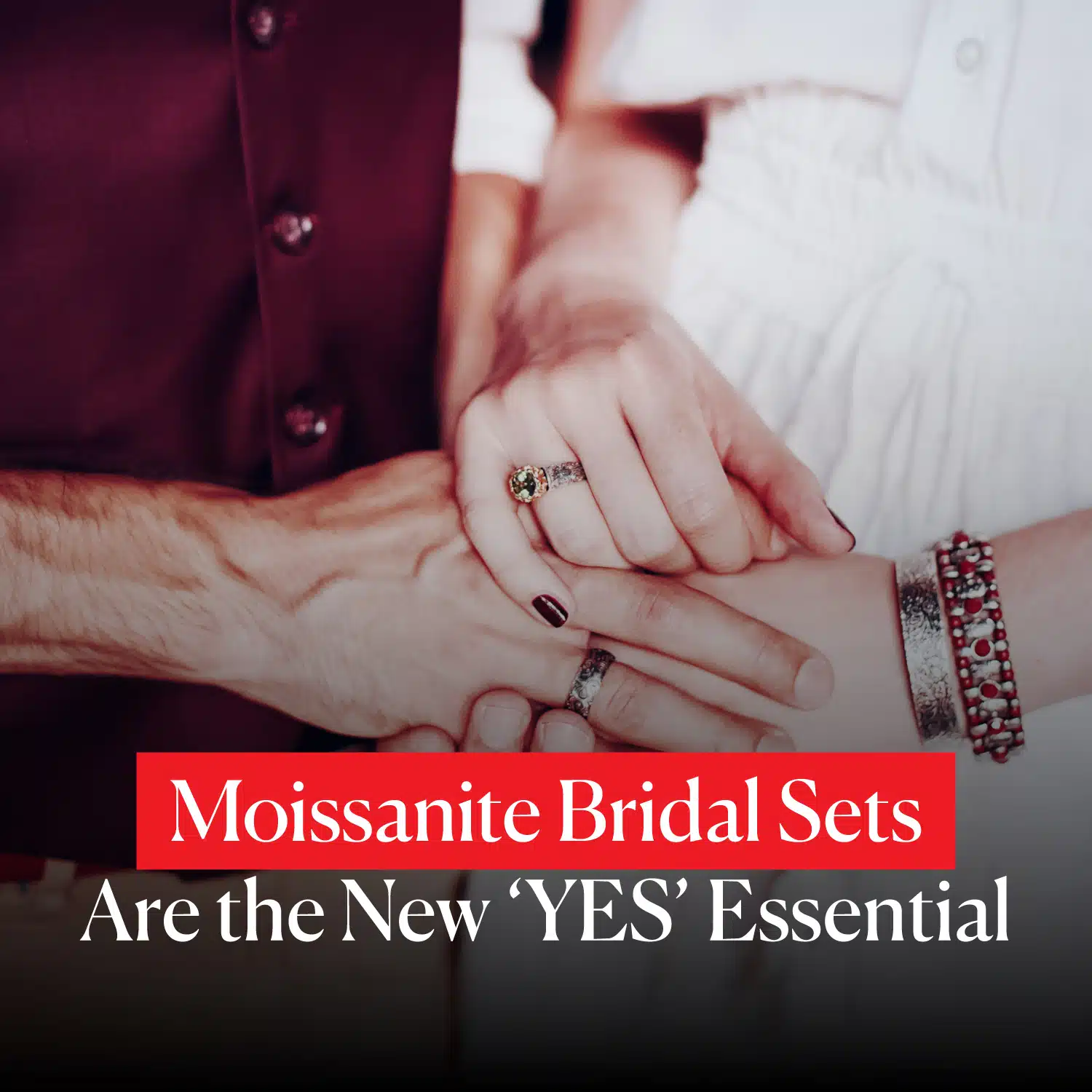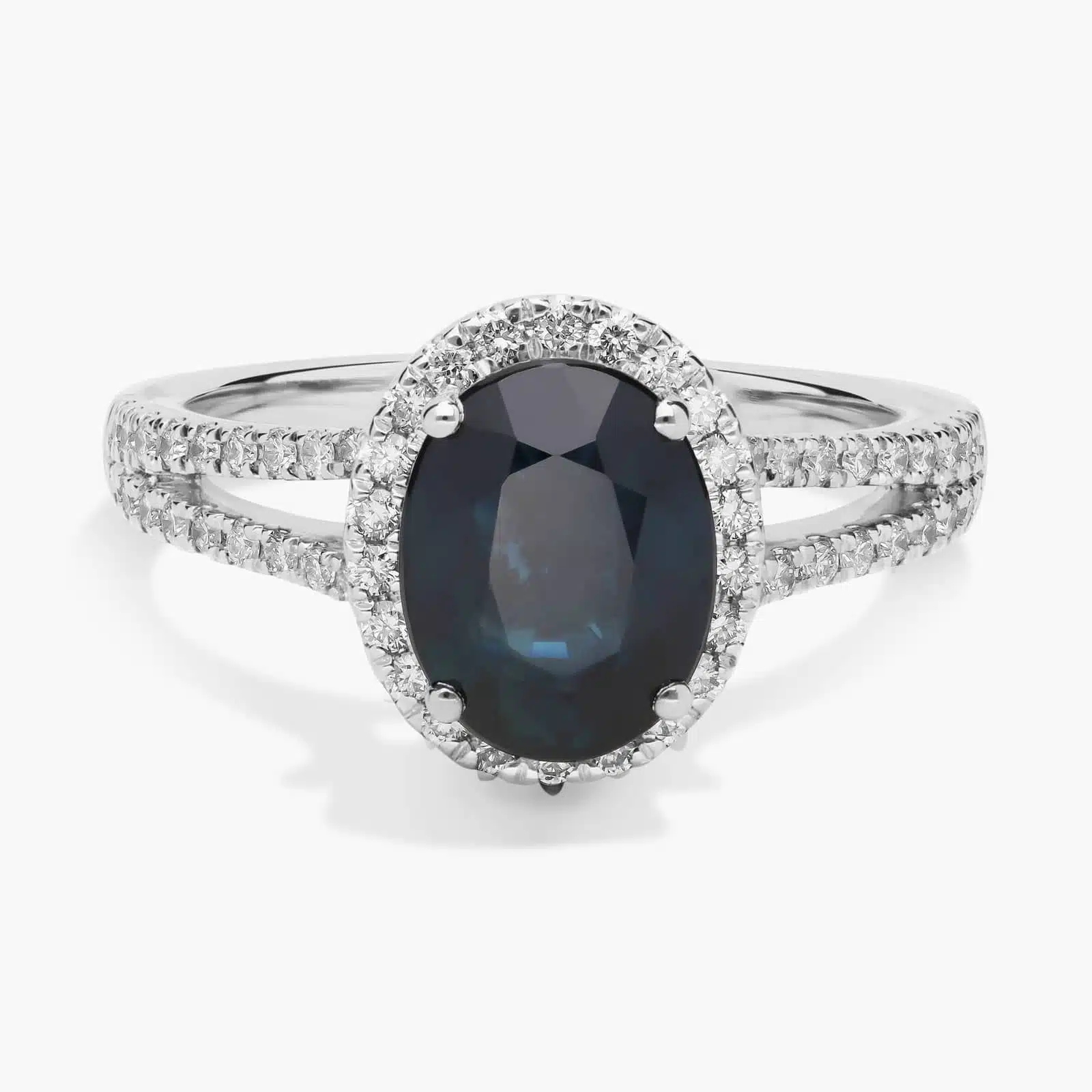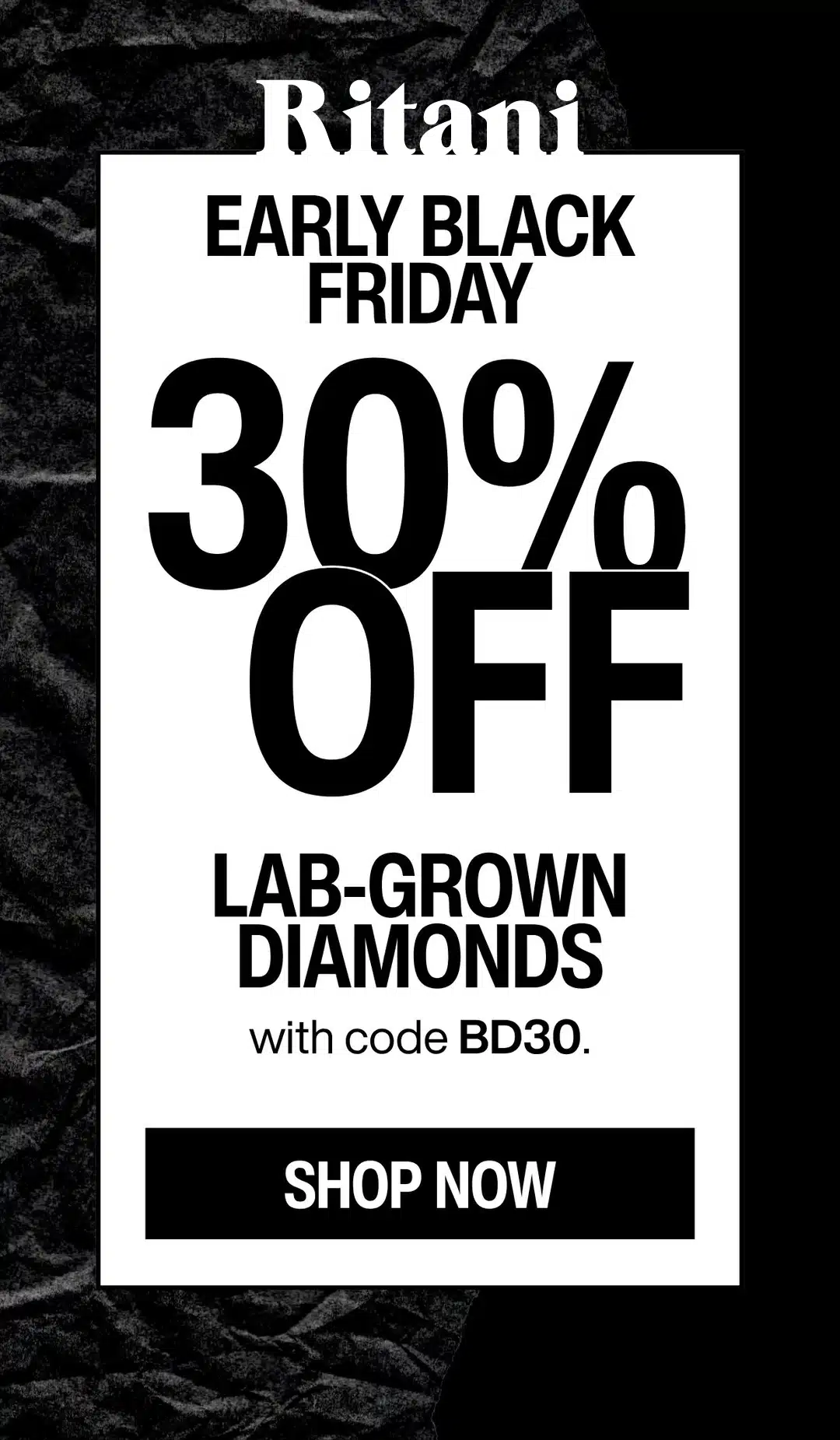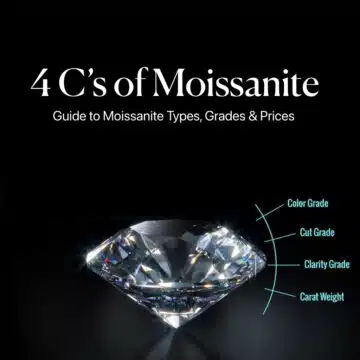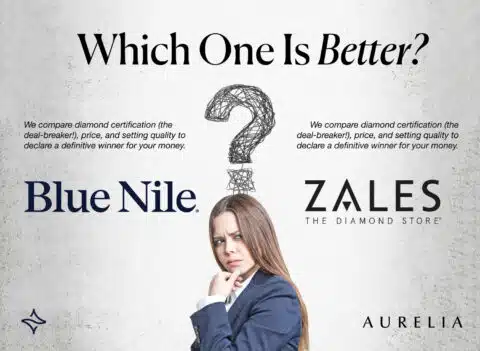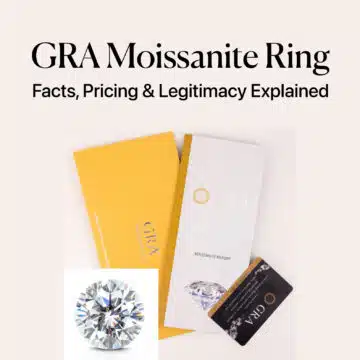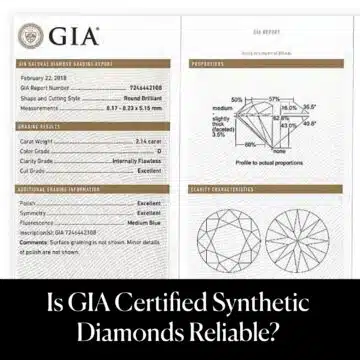Welcome to April, a month vibrant with spring’s energy and celebrated with a gemstone as brilliant as the season itself. If you’ve been asking, “which one is the April birthstone?”, the answer is unequivocally the diamond. This iconic gem is the primary and most recognized birthstone for the month of April, known the world over for its unparalleled sparkle and hardness.
Much like exploring the vibrant shades of the January birthstone color or the vibrant shades of the February birthstone color, April’s stone has a captivating story and incredible depth. The primary April birthstone is, of course, the diamond – a gem synonymous with brilliance, resilience, and timeless beauty. This isn’t just any gemstone; the diamond holds a singular place in history and human affection.
My goal with this guide is to take you on a comprehensive journey through everything you need to know about the April birthstone. We’ll uncover its ancient history and powerful meaning, delve into the cutting-edge science that gives it unparalleled sparkle, and explore the crucial factors that determine its value – the renowned Diamond 4Cs.
Beyond the diamond, we’ll also look at the fascinating alternative gems associated with April. Get ready to become an expert on this dazzling birthstone.
- The Deep Roots of April's Gem: A History Uncovered
- Decoding Diamond Quality: An In-Depth Look at the 4 Cs
- Beyond the Diamond: Exploring April Birthstone Alternatives
- Symbolism, Meaning, and Energy of April's Gems
- April Birthstone Jewelry: Styles, Settings, and Choosing Your Piece
- Caring for Your April Birthstone Jewelry: Keeping It Radiant
- Frequently Asked Questions About the April Birthstone
- Celebrating the Brilliance and Meaning of April's Birthstone
The Deep Roots of April’s Gem: A History Uncovered
The story of the April birthstone isn’t simply geological; it’s a rich narrative deeply intertwined with human history, myth, and culture. For centuries, these extraordinary crystals of compressed carbon have captivated civilizations, revered for their unparalleled hardness and dazzling beauty. Their journey from ancient riverbeds to iconic symbols is truly fascinating.
Ancient Origins and Early Beliefs
Our earliest confirmed accounts of diamonds place them in India, where they were first discovered in riverbeds as early as the 4th century BCE. These initial alluvial finds were rare and quickly became symbols of immense power and wealth, accessible only to royalty and the highest echelons of society.

The gem’s incredible durability was recognized almost immediately. Pliny the Elder, the Roman philosopher, wrote in the 1st century AD about the diamond’s use as an engraving tool, highlighting a practical application for its unmatched hardness even in the ancient world. This inherent strength is reflected in the gem’s name itself; “diamond” is derived from the ancient Greek word “adamas,” meaning “invincible,” “unbreakable,” or “unconquerable.”
This perceived invincibility fueled a wealth of folklore and mythical origin stories across various cultures. Some ancient beliefs held that diamonds were tears of the gods, while others thought they were fragments of fallen stars or even solidified lightning bolts.
The Sanskrit word for diamond, vajra, translates to “thunderbolt,” linking the gem to celestial power. Beyond mythology, diamonds were valued as powerful talismans. Throughout the Middle Ages and Renaissance, they were not just worn for adornment but also believed to offer protection against evil, endow the wearer with courage, and even possess healing properties for various ailments.
So potent was their symbolism that by the 13th century, King Louis IX of France reportedly decreed that only the monarch could possess diamonds, a law that underscored their status as gems of ultimate authority.
Historical Shifts, Alternative Gems, and Mining Revolutions
While the diamond stands alone as the modern April birthstone, the month’s history is shared with other significant gems. Older traditions and lists sometimes associated April with Lapis Lazuli, a deep blue stone linked to ancient texts like the Breastplate of Aaron.
Sapphire, another durable blue gem known for its beauty and symbolism of wisdom, also held a place as an April stone for a period before being assigned to September in later lists. Even the Opal was connected to April in certain historical astrological systems.
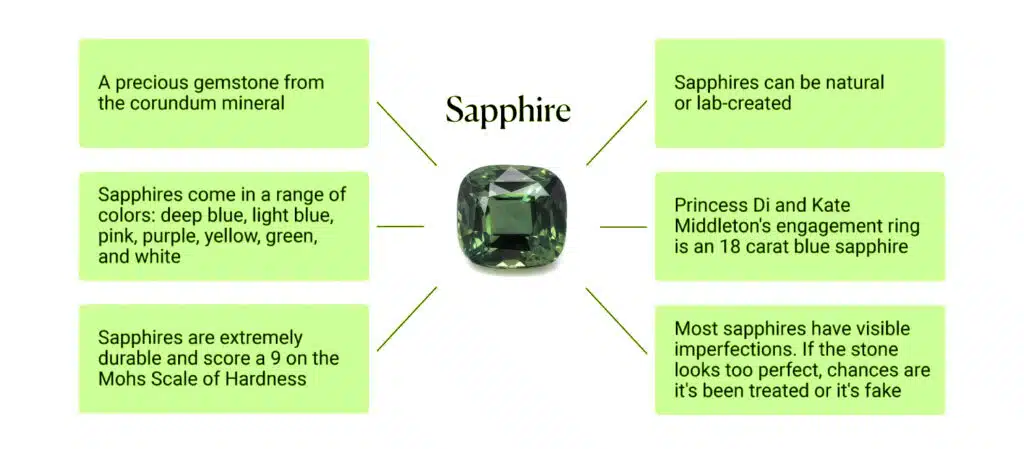
While not the primary stone, the enduring appeal of blue sapphires is undeniable, and the unique fire of opal still resonates today, showcasing the variety of gems historically or alternatively linked to this month.
The global availability and perception of diamonds underwent dramatic changes with major geological discoveries. The finding of significant diamond deposits in Brazil in the early 18th century marked the first major source outside of India, increasing their presence and influence, particularly in Europe.
However, the most transformative discoveries occurred in South Africa in the late 19th century. Mines like the legendary Kimberley deposit unearthed vast quantities of diamonds, leading to an unprecedented supply. This era, beginning around the 1870s, shifted diamonds from being exclusively royal treasures to becoming more accessible to a wider (though still affluent) public.
Understanding that these stones were formed deep within the Earth’s mantle, often at depths of typically over 100 miles – and brought to the surface by rare volcanic events in kimberlite pipes, highlights the incredible natural processes involved.
From Crown Jewels to Modern Icons: The Diamond’s Enduring Legacy
The link between diamonds and royalty continued strong into the modern era, solidified by their inclusion in national regalia and their prominence in famous jewels. Stories like that of the Cullinan Diamond, the largest gem-quality rough diamond ever found (discovered in 1905), and how it was cut into stones for the British Crown Jewels, exemplify this connection.
The captivating history of the Hope Diamond, its rare blue color and tales of its journey through various famous owners, adds another layer to the diamond’s mystique.

It was in 1912 that the American National Association of Jewelers formally standardized the list of birthstones, officially designating the diamond as the sole primary birthstone for April. This decision cemented its status based on centuries of tradition, desirability, and its unique physical properties.
The diamond’s association with enduring love was famously popularized in the 20th century, making it the quintessential gem for engagement rings and a traditional stone for milestone anniversaries like the 10th and 60th.
This rich history continues to influence jewelry design today; classic settings favored by historical figures are still popular, and retailers like Blue Nile, James Allen, Ritani, and Taylor & Hart offer a wide range of diamond jewelry that carries forward this legacy, from iconic solitaires to intricate vintage-inspired pieces.
The April birthstone’s journey through time is a testament to its extraordinary beauty, resilience, and enduring power to capture the human imagination.
Diamond IQ Test: Natural or Lab-Grown?
Two identical diamonds: GIA Certified, 1.51ct, D Color, VVS1, Ideal Cut. One is natural ($16,530), the other is lab-grown ($2,390). Choose the diamond you like better and see if you can match it to its origin.
Decoding Diamond Quality: An In-Depth Look at the 4 Cs
When you hear diamond experts talk about quality, they invariably refer to the 4 Cs: Cut, Color, Clarity, and Carat Weight. These four factors are the universal standard used globally to evaluate and grade diamonds.
Think of them as the DNA of a diamond, each contributing to its unique appearance, rarity, and ultimately, its value. While they are listed separately, they are highly interconnected, and a change in one C can significantly impact the others and the diamond’s overall appeal.
Cut: The Master of Sparkle
Perhaps the most crucial C for a diamond’s visual beauty is its Cut. It’s a common misconception that Cut refers to the diamond’s shape (like round or princess), but it actually refers to the proportions, symmetry, and polish of a diamond’s facets.

A diamond’s ability to sparkle, to return light to your eye, is almost entirely dependent on how well it is cut. Even a diamond with perfect color and clarity will appear dull if it has a poor cut.
An expertly cut diamond acts like a miniature light show. When light enters the diamond, it reflects off the internal facets and is refracted (bent) and dispersed (split into rainbow colors) as it exits the top of the stone. A diamond cut to ideal proportions maximizes this light return, creating brilliant white light (“brilliance”), flashes of rainbow colors (“fire”), and sparkling contrasts between light and dark areas (“scintillation”). A poorly cut diamond, on the other hand, will allow light to escape from the sides or bottom, resulting in less sparkle.
Diamond cut quality is graded on a scale, with the top grades indicating superior light performance. While grading scales can vary slightly by laboratory, common grades for round brilliant diamonds include Excellent (or Ideal), Very Good, Good, Fair, and Poor.
An Excellent cut means the diamond’s proportions, symmetry, and polish are near perfect, maximizing its interaction with light. Conversely, a Poor cut will result in a noticeably dull appearance. Understanding what goes into these grades is key, and a diamond cut chart can offer a visual guide to the different proportion impacts.
The diamond’s shape, while distinct from cut quality, works in conjunction with it. Different shapes like round shape (certain shapes like marquise or pear can appear larger face-up than a round diamond of the same carat weight) each have their own ideal cutting parameters to maximize brilliance and fire within that shape.
For example, the Round Brilliant is specifically designed to maximize light return, which is why it’s often considered the most brilliant shape.
Because cut is so vital to a diamond’s beauty, a higher cut grade significantly impacts price. The difference in cost between an Excellent cut diamond and a Good cut diamond of the same carat, color, and clarity can be substantial, often adding hundreds or even thousands of dollars.
But for many, the investment in a superior cut is worthwhile because it unlocks the diamond’s full potential for sparkle.
| Cut Grade | Light Performance Impact | Common Appearance | Price Impact (Relative) |
| Excellent | Maximizes brilliance, fire, and scintillation | Extremely bright, vibrant sparkle | Highest |
| Very Good | Very good light return, nearly all light reflected | Bright, noticeable sparkle | High |
| Good | Good light return, some light escapes | Noticeable sparkle, less intense | Moderate |
| Fair | Significant light leakage | Limited sparkle, appears duller | Lower |
| Poor | Minimal light return, appears dark or glassy | Very little to no sparkle | Lowest |
Color: The Absence of Hue
Diamond Color refers to the natural tint present in a white diamond. The grading scale for color is standardized by the GIA (Gemological Institute of America) and ranges from D to Z. This scale measures the absence of color, not the presence.
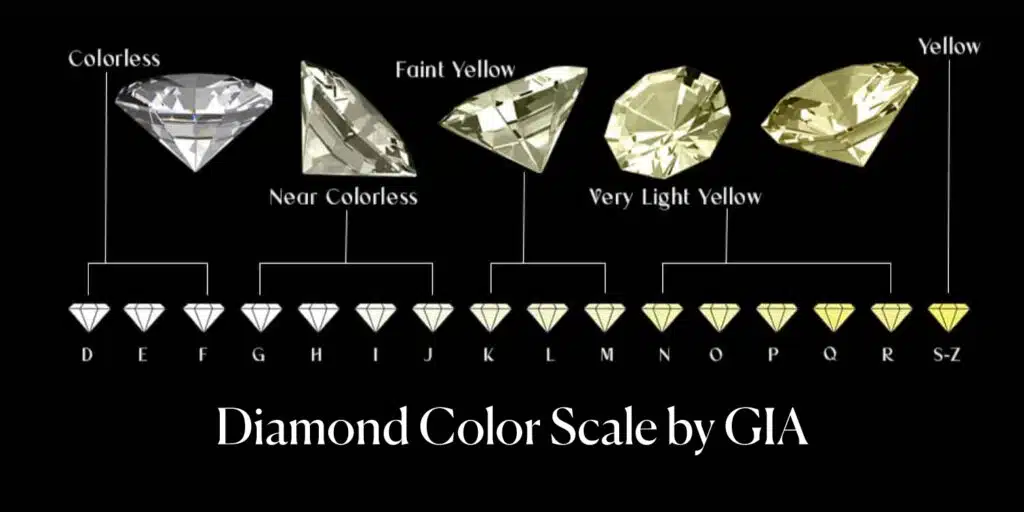
A D-grade diamond is absolutely colorless, the rarest and most valuable. As you move down the alphabet, the diamond shows increasing amounts of yellow or brown tint.
- D-F: Colorless – The most rare and valuable grades. No discernible color.
- G-J: Near-Colorless – These diamonds appear colorless to the naked eye, especially when mounted in jewelry. A faint yellow tint may be detectable only when compared to a D-F diamond or viewed loose.
- K-M: Faint Yellow – A noticeable yellow tint.
- N-R: Very Light Yellow – A clearly visible yellow tint.
- S-Z: Light Yellow – A distinct yellow or brown tint.
The most popular range for engagement rings and fine jewelry falls within the Near-Colorless range (G-J) because they offer a beautiful, colorless appearance face-up but at a lower cost than the truly colorless (D-F) grades.
The metal setting can also influence how color appears; a J-color diamond in a yellow gold setting might appear whiter as the gold’s warmth can mask the diamond’s faint yellow tint. A diamond color chart provides a helpful visual representation of these grades.
While the D-to-Z scale applies to white diamonds, diamonds also occur in vibrant Fancy Colors (e.g., pink, blue, yellow, green, red, black). These are graded on a separate scale based on the intensity of their hue (e.g., Fancy Light, Fancy Intense, Fancy Vivid).
Fancy colored diamonds are extremely rare, and unlike white diamonds where the absence of color increases value, the presence and intensity of color drive their value significantly. This is why understanding what color diamond is the most expensive means looking beyond the white scale to the incredibly rare Fancy Vivid colors.
The difference in price between adjacent color grades can be substantial, particularly in the colorless and near-colorless ranges. For instance, the jump from an F to a G color can sometimes represent a significant percentage increase in price for otherwise identical diamonds.
| Color Grade | Description | Appearance (Face-up in Jewelry) | Rarity / Value (Relative) |
| D-F | Colorless | Absolutely no color tint | Highest |
| G-J | Near-Colorless | Appears colorless (especially mounted) | High |
| K-M | Faint Yellow | Slight yellow tint noticeable | Moderate |
| N-R | Very Light Yellow | Clearly visible yellow tint | Lower |
| S-Z | Light Yellow/Brown | Distinct yellow/brown tint | Lowest |
Clarity: Nature’s Fingerprint
Diamond Clarity refers to the presence or absence of internal characteristics called inclusions and external characteristics called blemishes. These are like nature’s fingerprints, unique to each diamond, formed during its creation process deep within the Earth.
The clarity grading scale assesses the number, size, relief, nature, and position of these characteristics, and how they impact the diamond’s appearance and durability.

The GIA Clarity scale has six main categories, some divided, resulting in 11 specific grades:
- FL (Flawless): No inclusions or blemishes visible under 10x magnification. Extremely rare.
- IF (Internally Flawless): No inclusions visible under 10x magnification, only minor blemishes. Very rare.
- VVS1 and VVS2 (Very, Very Slightly Included): Minute inclusions that are extremely difficult to see under 10x magnification, even for a skilled grader.
- VS1 and VS2 (Very Slightly Included): Minor inclusions that are difficult to see under 10x magnification.
- SI1 and SI2 (Slightly Included): Inclusions that are noticeable under 10x magnification. In SI1 and SI2, inclusions may or may not be visible to the naked eye, depending on their size, type, and location.
- I1, I2, and I3 (Included): Inclusions that are obvious under 10x magnification and usually visible to the naked eye. These inclusions can sometimes affect the diamond’s transparency and durability.
For most people, the goal is to find an “eye-clean” diamond – one where inclusions are not visible without magnification. This is often found in the VS and SI ranges, offering a significant value compared to the Flawless or VVS grades, which command premium prices due to their rarity, even if their internal perfection isn’t visible to the naked eye.
Understanding diamond clarity often comes down to finding this balance between visible perfection and budget. Common types of inclusions include crystals (tiny mineral bits), feathers (small cracks), clouds (clusters of pinpoint inclusions), and needles (thin crystals). Blemishes are surface imperfections like scratches or polish lines.
The position of an inclusion is also important; an inclusion in the center of the diamond is more noticeable than one near the girdle (edge) that might be covered by the setting. While some inclusions can impact a diamond’s structural integrity, most inclusions, especially in the VS and SI ranges, are merely cosmetic and do not affect durability.
| Clarity Grade | Description (under 10x mag) | Eye-Clean Potential | Rarity / Value (Relative) |
| FL | No inclusions or blemishes | Always | Extremely High |
| IF | No inclusions, only minor blemishes | Always | Very High |
| VVS1 / VVS2 | Extremely difficult to see inclusions | Always | Very High |
| VS1 / VS2 | Difficult to see minor inclusions | Typically eye-clean | High |
| SI1 / SI2 | Noticeable inclusions | Often eye-clean (careful inspection needed) | Moderate |
| I1 / I2 / I3 | Obvious inclusions (under 10x mag and usually eye) | Rarely | Lower |
The price difference between clarity grades can be significant, particularly between the higher grades. The jump from an IF to a VVS1, while representing a technical difference, may not be visually discernible but commands a higher price due to rarity. Finding a beautiful, eye-clean SI1 or SI2 diamond can offer excellent value.
Carat Weight: The Measure of Size (and Rarity)
Diamond Carat Weight is perhaps the most widely known of the 4 Cs, and often the first characteristic people think of when considering a diamond. However, it’s important to remember that “carat” is a unit of weight, not size, although size is certainly correlated with weight.
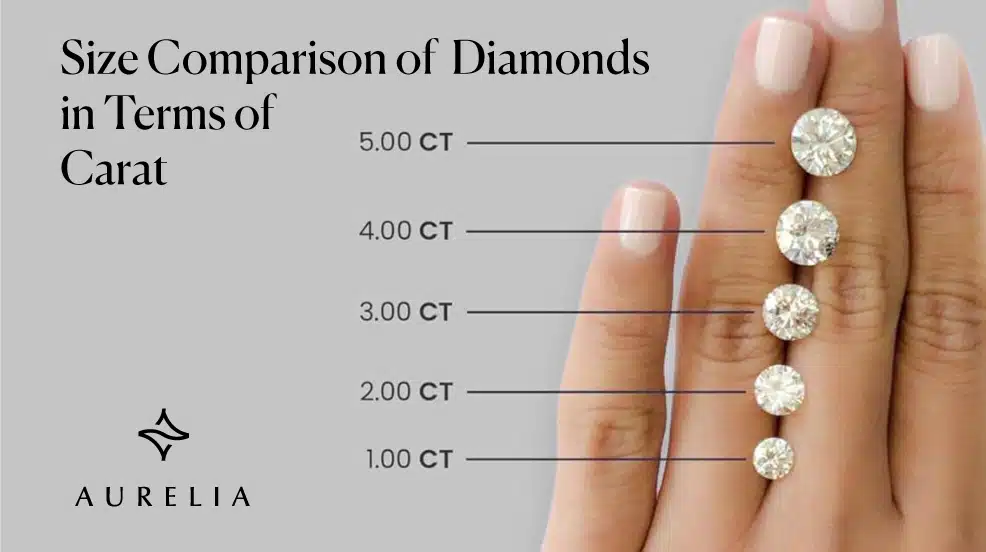
One metric carat is defined as 200 milligrams, or 0.2 grams. Carat weight is measured precisely to the hundredth decimal place (e.g., 1.50 carats).
While carat weight indicates how heavy a diamond is, its actual visible size (dimensions in millimeters) is also influenced by its shape and, crucially, its cut. A diamond cut too deep may hold more weight at the bottom (increasing carat weight) but appear smaller face-up than a well-proportioned diamond of the same weight. Conversely, a diamond cut too shallow might appear larger face-up but could lack brilliance and fire.
For Round Brilliant diamonds, there are typical millimeter diameters associated with common carat weights. A diamond carat size chart can give you a good estimate, but these are averages, and the exact dimensions will vary based on the diamond’s specific cut proportions.
For instance, a 1.00 carat Round Brilliant diamond typically measures approximately 6.5 mm in diameter.
| Carat Weight | Approx. Diameter (Round Brilliant) |
| 0.25 ct | 4.1 mm |
| 0.50 ct | 5.1 mm |
| 0.75 ct | 5.9 mm |
| 1.00 ct | 6.5 mm |
| 1.50 ct | 7.3 mm |
| 2.00 ct | 8.2 mm |
| 3.00 ct | 9.4 mm |
The relationship between carat weight and price is not linear; it’s exponential. This is because larger diamonds are significantly rarer than smaller ones. A 2.00 carat diamond of a given quality will cost much more than twice the price of a 1.00 carat diamond of the same quality.
For example, while you might budget a certain amount for a 1 carat diamond, understanding a 3 carat diamond ring illustrates just how dramatically price scales with size due to this rarity factor.
While carat weight is often the most significant driver of a diamond’s price, it’s essential to remember that it’s just one of the 4 Cs. A larger diamond with poor cut, color, or clarity may be less beautiful and less valuable than a smaller diamond with excellent grades in those areas. Prioritizing the 4 Cs based on what is most important to you (sparkle, visible perfection, size) is key to finding the right diamond within your budget.
The Interplay of the 4Cs and the Role of Certification
Understanding the 4 Cs individually is important, but truly evaluating a diamond means understanding how they interact. For instance, in certain diamond shapes, color can be more visible than in others (e.g., color is often more apparent in Emerald or Asscher cuts than in Round Brilliants).
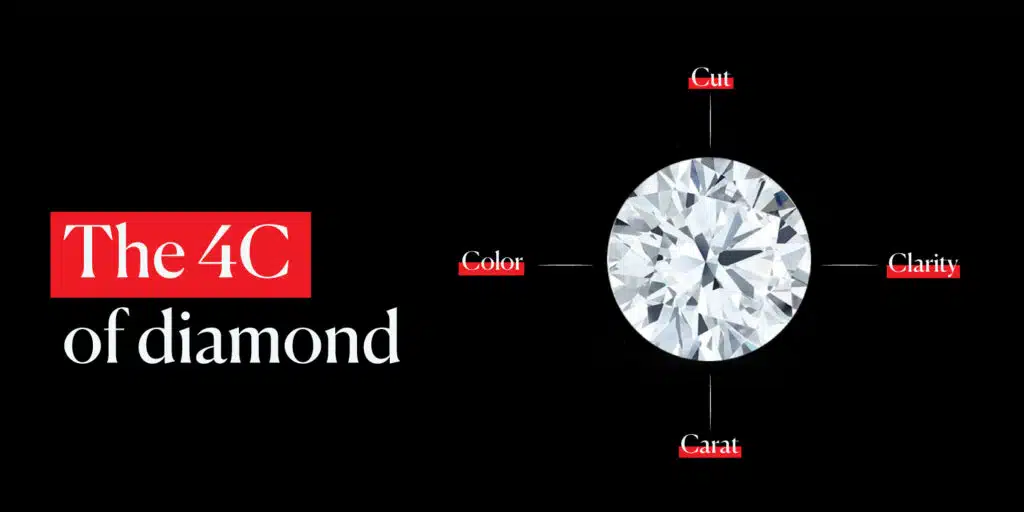
Similarly, the location and type of an inclusion (clarity) can be more or less noticeable depending on the cut and the diamond’s shape. This is where expertise comes in, helping you balance the 4 Cs to get the best overall diamond for your needs.
Finding the “sweet spot” where a diamond appears beautiful to the naked eye without paying a premium for grades that aren’t visually discernible is a common goal for savvy buyers. This often involves prioritizing Cut above all else, and then finding acceptable grades in Color and Clarity that offer an eye-clean appearance without a strong yellow or brown tint.
The Relative Impact of the 4 Cs on Value
While all 4 Cs contribute to value, their relative impact isn’t equal across the board, and it can vary depending on the range of grades you are considering. For example, within higher grades, rarity premiums are significant. However, when focusing on visual beauty and value, Cut often has the most dramatic impact on how beautiful a diamond looks.
| C Factor | Impact on Visual Beauty | Typical Relative Price Impact (Mid-Range: G-I Color, VS1-SI1 Clarity, 0.75ct – 1.50ct) |
| Cut | Highest | Excellent vs. Good can be a 10-20%+ difference or more for peak sparkle |
| Carat | Moderate (Size) | Exponential increase; jump from 1.00ct to 1.50ct is >> 50% price increase |
| Color | Moderate | D to F is a large jump; G to H is less so, but still noticeable |
| Clarity | Moderate (unless I1-I3) | FL/IF to VVS is a huge jump; VS1 to VS2 or SI1 to SI2 less so (focus on eye-clean) |
This table illustrates typical trends. Actual percentages vary greatly based on specific grades, carat weight, shape, and market conditions.
This table highlights that while Carat Weight often drives the base price, investing in a superior Cut often yields the greatest return in terms of visible sparkle and beauty for your money, especially in common jewelry sizes.
Given the complexity and the subtle differences that can significantly impact value, independent certification from a reputable gemological laboratory is absolutely critical. Organizations like the GIA and AGS are highly respected for their stringent and consistent grading standards. A diamond’s grading report provides an objective assessment of its 4 Cs and other characteristics, giving you confidence in what you are purchasing.
Always insist on a grading report from a well-regarded lab when buying a diamond. Tools like a diamond rate calculator or diamond appraisal calculator, while not definitive, often use the 4 Cs from these reports as primary inputs to estimate value.
Beyond the Diamond: Exploring April Birthstone Alternatives
For many months, there’s more than one gemstone recognized as a birthstone. This tradition stems from various historical lists and provides options that cater to different tastes and price points. April is no exception.
While the modern list firmly places the diamond as the primary birthstone, other beautiful and meaningful gems have been, or are sometimes, associated with this month, offering wonderful alternatives for jewelry.
White Sapphire: A Durable and Elegant Alternative
One of the most popular and practical alternatives to a diamond for April is the White Sapphire. Sapphires are part of the corundum mineral family, which is known for its excellent hardness – scoring a 9 on the Mohs scale.

This makes white sapphire incredibly durable, second only to the diamond itself (which scores a 10). This high level of hardness means white sapphire is well-suited for everyday wear, including in rings, which require a tough stone to resist scratching and abrasion.
Visually, a well-cut white sapphire can, at first glance, resemble a diamond. It is naturally colorless and transparent, allowing light to pass through it. However, its optical properties are different from a diamond.
While it exhibits good brilliance (white light reflection), it lacks the strong dispersion, or “fire,” that diamonds are famous for – the ability to split light into spectral colors. This means a white sapphire will sparkle with white light but won’t display the rainbow flashes you see in a diamond.
One of the most significant advantages of choosing a white sapphire is its cost. White sapphires are considerably more affordable than diamonds of comparable size and quality. This makes them an excellent option for someone who loves the look of a large, colorless stone but has a more modest budget.
Despite being a different mineral, sapphires hold their own historical significance and symbolism, often associated with wisdom, royalty, and serenity. While blue sapphires are the most iconic, the colorless variety offers a beautiful and durable alternative for April birthdays or other celebrations.
Clear Quartz: The Accessible and Meaningful Choice
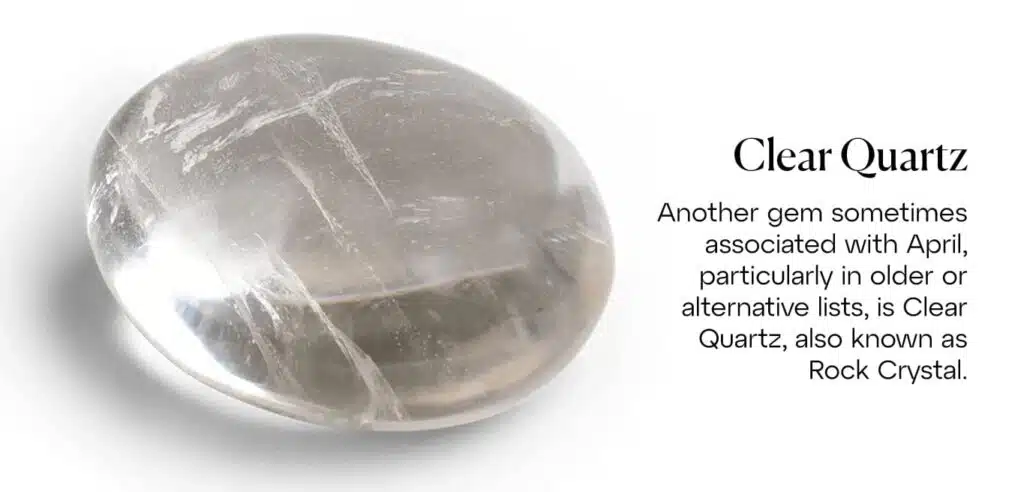
Another gem sometimes associated with April, particularly in older or alternative lists, is Clear Quartz, also known as Rock Crystal. Quartz is one of the Earth’s most abundant minerals, composed of silicon and oxygen atoms (SiO₂). It is a transparent, colorless gemstone, similar in appearance to glass when polished.
On the Mohs hardness scale, Clear Quartz scores a 7. This makes it durable enough for jewelry, particularly earrings and pendants, but it is significantly softer than both diamond (10) and white sapphire (9). A quartz stone is more susceptible to scratches from everyday objects, even dust (which can contain harder minerals), and is less recommended for rings intended for daily, rigorous wear unless set in a protective setting.
The primary appeal of Clear Quartz as an alternative April birthstone lies in its accessibility and affordability. Due to its abundance, it is much less expensive than diamonds or sapphires, making beautiful birthstone jewelry available at very approachable price points. Beyond its affordability, Clear Quartz holds deep meaning in various spiritual and metaphysical traditions.
It’s often referred to as the “Master Healer” and is associated with energy amplification, clarity of thought, and emotional healing. While it doesn’t possess the diamond’s intense brilliance or fire, its clear transparency and historical symbolism offer a different kind of beauty and significance.
Other April Associations: Historical Context
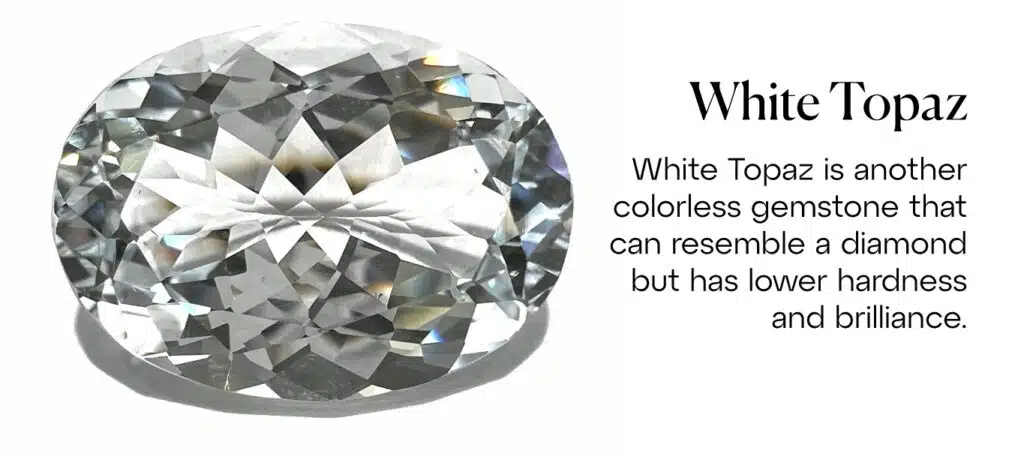
As mentioned in our history section, gemstone associations have evolved over time. While not commonly listed today, gems like White Topaz (Mohs 8) were sometimes linked to April. White Topaz is another colorless gemstone that can resemble a diamond but has lower hardness and brilliance.
Its historical association and affordability might make it appear in some older resources or niche jewelry lines. Similarly, the Opal, primarily known as the October birthstone, held an association with April in some ancient astrological systems.
While the vibrant “play of color” is opal’s signature, colorless or white opals exist, and their inclusion in certain historical April lists adds a fascinating layer to the month’s gemstone story, though the durability of opal is a key consideration due to their lower Mohs score (5.5-6.5).
Making Your Choice: Finding the Right April Gem
With options ranging from the unparalleled diamond to the durable white sapphire and the accessible clear quartz, choosing an April birthstone involves considering what matters most to you or the gift recipient.
If ultimate durability, unmatched brilliance, and traditional symbolism are the top priorities, and budget allows, the diamond remains the classic and enduring choice. Understanding the diamond clarity or diamond color within your budget becomes essential here, as discussed in the 4Cs section.
If you need a highly durable stone suitable for daily wear, including rings, that offers a colorless look at a significantly lower price point than diamond, White Sapphire is an excellent, practical, and beautiful alternative.
If affordability is the primary driver, or if the symbolic and metaphysical properties of the stone are a key focus, and the jewelry piece (like earrings or a pendant) is less exposed to potential impacts and abrasion, Clear Quartz offers a lovely and meaningful option.
Considering the intended use of the jewelry is also important. A white sapphire ring is a great diamond alternative for an engagement ring or daily wear, while clear quartz might be better suited for a birthday pendant or earrings.
Here’s a quick comparison of the primary April birthstone and its two most common alternatives:
| Feature | Diamond (Primary) | White Sapphire (Alternative) | Clear Quartz (Alternative) |
| Composition | Pure Carbon | Aluminum Oxide (Corundum) | Silicon Dioxide |
| Mohs Hardness | 10 (Hardest Natural Mineral) | 9 (Second Hardest Natural Mineral) | 7 |
| Sparkle Level | Highest (Brilliance, Fire, Scintillation) | High Brilliance, Low Fire | Moderate Brilliance, No Fire |
| Typical Cost (Relative) | Highest | Moderate (Significantly lower than Diamond) | Lowest (Most Affordable) |
| Durability for Rings | Excellent (Very resistant to scratches) | Excellent (Very resistant to scratches) | Fair (Prone to scratching) |
| Key Appeal | Brilliance, Hardness, Rarity, Tradition, Symbolism of Eternal Love | Durability, Colorless Appearance, Value, Symbolism of Wisdom | Affordability, Transparency, Metaphysical Properties (Healing, Energy) |
Ultimately, the choice between a diamond and its alternatives for an April birthstone gift or personal piece comes down to balancing these factors. Each stone offers beauty, meaning, and its own unique place in the history and tradition of April gems.
Symbolism, Meaning, and Energy of April’s Gems
Gemstones often serve as more than just adornment; they are imbued with meaning, reflecting human aspirations, values, and connections to the natural world. For those born in April, or those celebrating April milestones, their birthstone carries a particularly personal significance, representing qualities and energies associated with this time of year and the stones themselves.
Diamond Symbolism: Love, Strength, and Light
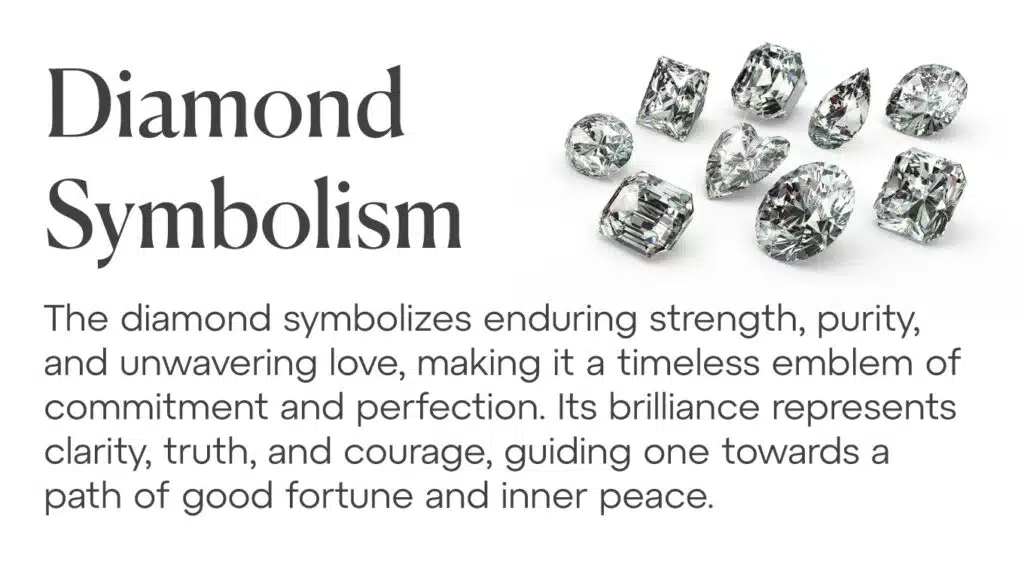
The diamond’s symbolism is perhaps the most universally recognized, largely centered around enduring love and commitment. This association is deeply tied to its legendary hardness and invincibility – qualities that metaphorically represent the strength and permanence of a loving bond.
This is why the diamond has become the ultimate gemstone for engagement rings and a traditional gift for milestone anniversaries like the 10th and 60th; it is seen as an everlasting symbol of fidelity and unbreakable connection.
Beyond love, the diamond also embodies strength, resilience, and courage. Its name, derived from the Greek “adamas” meaning “unconquerable,” directly reflects this. Wearing a diamond was historically believed to instill these very qualities in the wearer, providing fortitude and inner strength to overcome challenges.
Its dazzling brilliance and clarity also lend themselves to symbolism associated with purity, innocence, clarity of thought, and light. Diamonds are seen by some as beacons of truth and pure energy, cutting through confusion or negativity.
Historical Beliefs and Powers
Throughout history, various cultures attributed specific powers and magical energies to diamonds. As we touched upon in the history section, ancient beliefs often positioned diamonds as protective talismans. Warriors would wear them for courage and protection in battle, believing their invincibility would transfer to the wearer.
There were also widespread beliefs in the diamond’s ability to ward off evil spirits and offer protection against illness, poison, and even lightning strikes.
In the realm of historical healing beliefs, diamonds were thought to influence clarity of mind and balance. Some ancient texts even linked them to the brain and pituitary gland, believing they could help draw out toxins or address ailments related to the head.
While these are historical beliefs rather than scientifically proven properties, they highlight the profound respect and mystique surrounding diamonds throughout human history, viewing them as powerful conduits of energy and well-being.
Blue Nile is one of the biggest and most recognized online jewelry retailers, offering an extensive and exclusive inventory. Their high-resolution images are improving and getting closer to the quality offered by James Allen, while their prices remain highly competitive. Right now, Blue Nile offers up to 30% savings on jewelry during a limited-time sale.
WHAT WE LOVE ABOUT THEM:
- 30-day no-questions-asked return policy, with a prepaid shipping label provided by Blue Nile.
- Lifetime warranty on all purchases.
- Free shipping on every order.
- Complimentary services every six months, including prong tightening, repolishing, rhodium plating, and cleaning.
- Insurance appraisal included with your purchase.
- One free resizing within the first year.
- High-quality images available for roughly half of their diamond selection.
- 24/7 customer service support.
- Full credit toward future upgrades, as long as the new item is at least double the value.
- Best-in-class order fulfillment process.
Connecting to April Personalities (Aries & Taurus)
April falls under the influence of two zodiac signs: Aries (roughly March 21 – April 19) and Taurus (roughly April 20 – May 20). Interestingly, the core symbolism of the diamond resonates well with the traits often associated with these signs. Aries is known for being courageous, energetic, pioneering, and resilient – qualities mirrored by the diamond’s symbolism of strength and invincibility.
Taurus, associated with determination, reliability, and an appreciation for beauty and strength, also aligns with the diamond’s enduring nature and status as a valuable, unwavering gem. The diamond’s powerful energy is seen by some as a fitting companion for the assertive and grounded personalities born during this time.
Symbolism of Alternative April Gems
While the diamond dominates April’s symbolism today, the historical and alternative stones associated with the month also carry their own meaningful properties based on tradition and lore.
- Lapis Lazuli: Historically linked to April, Lapis Lazuli is a stone of truth, wisdom, and royalty. Its deep blue color symbolizes honor and divine connection.
- Sapphire: Another historical April gem, blue sapphires are primarily associated with wisdom, focus, serenity, and nobility. They are believed to calm the mind and enhance intuition.
- Clear Quartz: Often called the “Master Healer,” Clear Quartz symbolizes clarity, energy, and intention. It’s believed to amplify energy and thought, aid concentration, and promote emotional stability.
- Opal: While primarily October’s stone, Opal carries symbolism of luck, passion, and inspiration, with its unique play of color representing creativity and dynamic energy.
Metaphysical Properties: Beliefs and Energy
In various spiritual practices and crystal healing traditions (distinct from medical science), April’s birthstones are attributed specific metaphysical properties.
Traditionally, the diamond is believed to be a powerful energy amplifier, capable of enhancing the energy of other crystals and intentions. It is said to bring balance to the wearer, promote clarity of mind, and aid in spiritual insight. Some belief systems suggest diamonds can help in removing blockages and fostering overall well-being and energy flow.
Clear Quartz is widely recognized for its amplifying properties, often used to boost the energy of other stones or personal intentions. It is believed to cleanse negative energy, bring emotional balance, and enhance spiritual growth. Its clarity is seen as a symbol of mental and spiritual purification.
White Sapphire is traditionally associated with calm, focus, and self-expression. It’s believed to help clear the mind, reduce anxiety, and promote a sense of inner peace.
It is important to note that these metaphysical properties are based on historical beliefs, folklore, and spiritual traditions, not scientific or medical evidence. However, for many, the symbolic meaning and perceived energy of a gemstone add a significant layer of personal connection and intention to wearing their birthstone. Whether viewed through a lens of history, culture, or personal belief, April’s gems are undeniably rich in meaning.
James Allen is a top leader in online diamond sales, offering cutting-edge imaging technology that lets you inspect diamonds as if you were using a jeweler's loupe. With the largest exclusive selection of loose diamonds available online and excellent pricing, they also boast one of the finest collections of lab-created diamonds on the market. They currently run a 25% discount on selected lab-grown diamonds!
WHAT WE LOVE ABOUT THEM:
- 30-day no-questions-asked return policy, with a prepaid shipping label provided by James Allen.
- Lifetime warranty on all purchases.
- Free international shipping.
- Complimentary prong tightening, repolishing, rhodium plating, and cleaning every six months.
- Insurance appraisals included with purchases.
- One free resizing within 60 days of purchase.
- Free ring inscriptions available.
- Best-in-class high-quality imagery for every diamond in stock.
- 24/7 customer support.
- Premium, best-in-class packaging.
April Birthstone Jewelry: Styles, Settings, and Choosing Your Piece
Once you understand the beauty and value of April’s birthstones – primarily the diamond, along with its notable alternatives like white sapphire and clear quartz – the next step is to consider how these gems come to life in jewelry.
The design of a piece, particularly the setting and the metal used, plays a huge role not only in its aesthetic appeal but also in its durability, security, and even the perceived size and brilliance of the stone.
Popular April Birthstone Jewelry Types

April birthstones are versatile and feature prominently in a wide array of jewelry styles, suitable for various occasions and personal tastes. Perhaps the most iconic piece is the diamond engagement ring, a global symbol of commitment.
Beyond engagements, diamond rings are also incredibly popular for birthdays, anniversaries, and as fashion statements.
Other beloved types include necklaces, ranging from simple solitaire pendants that showcase a single, stunning stone to more elaborate designs like tennis necklaces or station necklaces. Earrings are another classic, with diamond or white sapphire studs being timeless staples, alongside hoop earrings adorned with gems or more elaborate drop designs.
Bracelets, such as elegant tennis bracelets or simple bangles featuring bezel-set stones, offer subtle ways to wear your April birthstone. These pieces are not only beautiful but also serve as meaningful personal talismans or cherished gifts.
Understanding Settings: Style Meets Security
The setting is the metal structure that holds the gemstone in place. It’s a critical design element that influences the jewelry’s style, protects the stone, and can even enhance or alter its appearance. Choosing the right setting is as important as selecting the stone itself.
- Solitaire: This classic setting features a single stone, typically held by prongs (often four or six). Its beauty lies in its simplicity, allowing the maximum amount of light to enter the diamond from all angles, truly showcasing its brilliance. It’s a timeless and elegant choice, particularly popular for engagement rings and pendants.
- Halo: In a halo setting, a central stone is surrounded by a circle (or “halo”) of smaller diamonds or other gems. This setting is designed to enhance the appearance of the center stone, making it look larger and adding significant overall sparkle. A halo can be a great way to make a modest-sized April birthstone, perhaps a 0.50 or 0.75 carat diamond, appear more substantial, potentially closer in perceived size to <a href=”https://moissanitebyaurelia.com/how-much-is-a-3-carat-diamond-ring/” target=”_blank”>how much is a 3 carat diamond ring</a> looks on the hand (in terms of overall presence), depending on the halo size.
- Pavé: This setting features many small gems set closely together, with minimal visible metal, creating a surface that appears “paved” with diamonds or other stones. Pavé is often used to adorn bands, halos, or the surface of pendants and earrings, adding overall sparkle and a luxurious feel.
- Three-Stone: This setting features a central stone flanked by two smaller stones. It’s a classic choice often said to symbolize the past, present, and future. It adds significant presence and sparkle.
- Bezel: In a bezel setting, a metal rim encircles the gemstone, holding it securely in place. This offers excellent protection for the stone’s girdle and edges and provides a clean, modern look. It’s a very secure setting, good for those with active lifestyles, though it can slightly reduce the amount of light entering the stone from the sides.
- Channel: In a channel setting, stones are set side-by-side within metal channels, with no metal separating them individually. This provides a smooth surface and protects the girdle of the stones.
The choice of setting impacts not only style and security but also cost and the gem’s visibility. A setting that allows more light into the stone (like prong settings) enhances sparkle, while a more protective setting (like a bezel) offers greater security but might slightly mute the light return.
Similarly, settings like halos or pavé will increase the total carat weight and complexity of the piece, thereby increasing the cost compared to a simple solitaire.
Choosing Your Metal
The metal used for the setting is another key decision, influencing the jewelry’s overall look, durability, and price. Popular choices for April birthstone jewelry include:
- Platinum: A premium white metal known for its exceptional durability, density, and hypoallergenic properties. Platinum is naturally white and does not require rhodium plating like white gold. Its strength makes it ideal for securing valuable gemstones, though it is the most expensive option.
- Gold: Available in various colors and purities (karats, such as 14k, 18k, 24k).
- Yellow Gold: A classic choice that offers a warm, traditional look. Higher karats (like 18k) have a richer color and are softer than lower karats (like 14k).
- White Gold: Created by alloying gold with white metals (like palladium or nickel) and typically plated with rhodium to enhance its whiteness. It offers a contemporary look and is a popular alternative to platinum. Rhodium plating wears off over time and may require re-plating.
- Rose Gold: Created by alloying gold with copper, giving it a pinkish hue. It offers a romantic and vintage-inspired look.
- Sterling Silver: While beautiful and affordable, sterling silver is much softer than gold or platinum and is more prone to scratching and tarnishing. It’s less commonly used for primary settings for valuable diamonds but can be a good choice for clear quartz or less frequently worn pieces.
The metal choice should complement the stone’s color and the wearer’s style and lifestyle. White metals (platinum, white gold) can emphasize the colorless nature of diamonds or white sapphires, while yellow or rose gold can add warmth or a contrasting aesthetic. The durability of the metal is also a key consideration, especially for rings worn daily.
The Significance of Gifting April Birthstone Jewelry
Gifting April birthstone jewelry is a deeply personal and meaningful gesture. Whether it’s for a birthday, a new baby, an anniversary, or another special occasion, a piece featuring a diamond or one of its alternatives symbolizes the qualities associated with the month: strength, love, resilience, and new beginnings.
A diamond, with its symbolism of eternal love, is a particularly potent gift for expressing lasting affection. Alternatives like white sapphire or clear quartz offer beautiful ways to celebrate April birthdays with thoughtfulness and beauty, providing options that cater to different budgets and preferences while still carrying the significance of the birthstone connection.
Ultimately, choosing April birthstone jewelry is about selecting a piece that resonates with the recipient, reflects their style, and carries the beautiful meaning of their special gem.
Ritani is a trusted name in the online jewelry industry, known for its stunning collection of ethically sourced diamonds and gemstones. With a focus on transparency, Ritani offers customers in-depth diamond education and innovative features like in-store preview options, ensuring a seamless and informed shopping experience.
WHAT WE LOVE ABOUT THEM:
- Free in-store preview of loose diamonds before purchase.
- 30-day free returns, including resizing services for all rings.
- Lifetime warranty that covers prong tightening, polishing, rhodium plating, and more.
- Free insured shipping on all orders.
- Access to a wide selection of GIA-certified diamonds and lab-grown options.
- High-resolution 360° videos of diamonds for accurate evaluation.
- Ethical sourcing and conflict-free diamonds.
- Buy Now, Pay Later financing options available.
- 24/7 customer service with personalized consultations.
Caring for Your April Birthstone Jewelry: Keeping It Radiant
Your April birthstone jewelry, whether a diamond, white sapphire, or clear quartz, is meant to be worn and enjoyed. With proper care, these pieces can truly last a lifetime and beyond. The good news is that routine cleaning and maintenance are relatively straightforward.
Safe Cleaning Methods at Home
For most April birthstone jewelry, the best way to keep it sparkling is with gentle, regular cleaning using simple household supplies. The most recommended method involves soaking your jewelry in warm water mixed with a few drops of mild dish soap.
After a few minutes of soaking, use a soft-bristled brush (like a soft toothbrush) to gently scrub the stone and its setting. This helps remove the accumulation of oils, lotions, and dirt that can dull a gem’s sparkle. Rinse the piece thoroughly under warm running water and dry it with a soft, lint-free cloth.
Many people also use ultrasonic cleaners for diamond jewelry, and they can be quite effective at removing stubborn dirt from intricate settings. However, caution is advised. While generally safe for most diamonds, ultrasonic vibrations can potentially loosen stones that are already set insecurely or exacerbate existing fractures or inclusions within a diamond, particularly those that reach the surface.
They should also not be used for softer April alternatives like clear quartz or opal, which can be damaged by the vibrations or heat. If you choose to use an ultrasonic cleaner, it’s safest for solid diamond pieces without visible inclusions or fractures, and always follow the manufacturer’s instructions.
Everyday Wear Best Practices
While diamonds are the hardest natural substance, they can still be damaged. A hard impact can chip or even fracture a diamond, and they can certainly scratch other gemstones or metals.
To protect your jewelry and your other belongings, it’s wise to remove your April birthstone rings or bracelets when engaging in activities that could expose them to harsh impacts, chemicals, or abrasion. This includes gardening, rigorous sports, heavy lifting, and household chores involving harsh cleaning products.
Chemicals found in everyday products like chlorine bleach, hairspray, perfumes, and lotions can dull the surface of your gemstone or even damage the metal setting over time. Make it a habit to apply cosmetics, perfumes, and lotions before putting on your jewelry, and remove rings before using cleaning supplies.
Caring for Alternative April Gems
While diamond care is often the primary focus, remember to tailor your approach for alternative April birthstones based on their hardness.
- White Sapphire (Mohs 9): Similar to diamonds, white sapphires are very durable and can withstand most cleaning methods suitable for diamonds, including gentle brushing and many ultrasonic cleaners (though always exercise caution). Their hardness makes them resistant to scratching during normal wear.
- Clear Quartz (Mohs 7): Being softer than diamond and sapphire, clear quartz jewelry is more susceptible to scratches. Clean with warm, soapy water and a soft brush. Avoid ultrasonic cleaners and be mindful of wearing rings in situations where they could encounter harder surfaces or grit.
- Opal (Mohs 5.5-6.5): Opals are considerably softer and also contain water, making them vulnerable to dehydration, heat, and chemicals. Clean only with mild soap and lukewarm water; never use harsh chemicals, ultrasonic cleaners, or expose them to sudden temperature changes or prolonged dry heat. Opal rings should be worn with extra care and are best reserved for occasional wear.
Professional Maintenance and Storage
Beyond regular home cleaning, having your April birthstone jewelry professionally cleaned and inspected periodically is highly recommended. A jeweler can give your piece a thorough cleaning using specialized equipment and, more importantly, check the security of the stone’s setting and prongs.
Prongs can wear down or become loose over time, and catching this early can prevent the devastating loss of a gemstone. An annual check-up is a good practice, especially for frequently worn items like rings.
Proper storage is also key to preventing damage. Because diamonds can scratch anything softer – which is virtually all other jewelry materials – store your diamond pieces separately from other jewelry. Use fabric-lined jewelry boxes, individual pouches, or dividers to keep items from rubbing against each other.
Store alternative gemstone jewelry appropriately as well, keeping softer stones away from harder ones. By following these simple care guidelines, you can ensure your April birthstone jewelry retains its stunning beauty and remains a cherished possession for years to come.
Frequently Asked Questions About the April Birthstone
Navigating the world of birthstones, especially one as significant as April’s diamond, can bring up several common questions. We’ve covered a lot of ground, but let’s directly address some of the things people most frequently ask about the April birthstone.
Celebrating the Brilliance and Meaning of April’s Birthstone
We’ve journeyed deep into the world of the April birthstone, uncovering a history as old as civilizations and exploring properties as remarkable as the stone’s sparkle itself. From its ancient origins in Indian riverbeds and its place in folklore and royal regalia, we’ve seen how the diamond earned its status.
We’ve explored the incredible science behind its unmatched hardness and fiery brilliance, and perhaps most importantly for anyone looking to own or gift this gem, we’ve decoded the crucial 4 Cs – understanding how Cut, Color, Clarity, and Carat Weight each contribute to a diamond’s unique beauty and value.
Beyond the iconic diamond, we’ve also embraced the significance of April’s historical and modern alternatives like the durable white sapphire and the meaningful clear quartz, recognizing that the perfect April gem comes in different forms, each with its own appeal and place.
We’ve touched on the rich symbolism these stones carry – representing everything from eternal love and strength to clarity and healing energy – and discussed the practical aspects of choosing settings and metals, as well as the essential steps to care for your cherished pieces.
Armed with this comprehensive knowledge, you’re now equipped to truly appreciate the depth and wonder of the April birthstone. Whether you choose the classic diamond, a resilient white sapphire, or a clear quartz, your April gem is more than just a beautiful object; it’s a piece of history, a symbol of powerful qualities, and a personal connection to this vibrant month.
I hope this guide has empowered you with the confidence to choose, wear, and cherish your April birthstone with a deeper understanding and appreciation for its incredible journey and enduring radiance.


